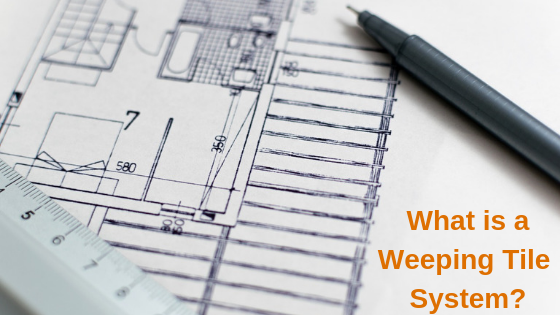Standing water next to a home is often a sign of an underlying issue, which could range from poor drainage to clogged gutters and leaky pipes. When a home’s foundation is exposed to water or moisture for a long time, it can begin to deteriorate, which may lead to concrete cracking and spalling. If ignored, a faulty foundation will continue to break down, eventually compromising the structural integrity of the home. There is some good news, though: regardless of the underlying causes, standing water along with all the structural damage it could cause can be avoided.
While there are different ways to prevent water from accumulating around your home, a weeping tile system is a great place to start. You are probably asking yourself right about now, “What in the world is a weeping tile system? Also known as a drain tile system, a weeping tile system basically consists of a porous pipe used for drainage. There are two basic ways to use a weeping tile system for your Houston home.
The Exterior Weeping Tile System
An exterior weeping tile system is, in fact, a French drain whose role is to direct water away from your foundation. To install this type of system, a trench needs to be dug around the outside perimeter of your foundation. The trench should be 9 to 12 inches wide and slope 1 inch for every 8 feet in length. It should also extend down to the base of your foundation’s footings.
After the trench is dug, the workers will apply 2 to 3 inches of gravel to its base. Then, a pre-perforated PVC pipe will be laid on top of the gravel. Wrapping the pipe in landscape fabric will stop soil, debris, roots, and other obstructions from getting inside the pipe and clogging it. To make maintenance easier, it is also good to leave a drain cleanout above the ground.
When installing an exterior weeping tile system, it’s recommended to use hard rocks, like washed river gravel or granite chips. Although you can find more affordable rock varieties, such as lime, marble, and pea gravel, they are softer than hard rocks. Since soft rocks tend to decompose into sand over time, they could clog the pipe and restrict the flow. In addition, the gravel should be 1-2 inches in diameter to ensure proper drainage.
Pre-planning is another important part of installing an exterior weeping tile system, as it can help you decide ahead of time where to relocate your plants, shrubs, and trees. Since digging a trench and filling it with gravel means that you’ll have a lot of soil left, you might also want to think beforehand about where to place all that soil.
The Interior Weeping Tile System
Unlike the exterior weeping tile system, which is installed outside the perimeter of the home, the interior weeping tile system is installed underneath the home. This means that the interior weeping tile system can be used as a second layer of protection against drainage issues.
To install this type of system, the workers will use a chipping hammer in conjunction with a diamond wire saw or a circular saw to remove the concrete along the perimeter of your foundation. Once the workers remove the concrete, they will dig a 1-to-2-foot-deep trench along the outer edge of the foundation. A pre-perforated, fabric-covered PVC pipe will then be placed inside the trench. While the fabric will allow the pipe to drain well, it’s important to place the perforations facing upwards to ensure the system will be most effective at collecting and removing excess water from around your foundation.
After placing the pipe inside the trench, the workers will need to fill the trench with gravel and connect the pipe to the sewer line or sump pipe. The workers will also pour new concrete to replace the concrete that was removed initially.
The installation of interior and exterior weeping tile systems is often a labor-intensive process. That’s why it can be quite expensive. An exterior system can cost anywhere from $10 to $75 per linear foot to install. The interior system will cost about half as much. Installing an interior system will also eliminate the need for removing plants and other landscaping features.
While it’s possible to put both the interior and exterior systems in by yourself, hiring a professional can save you a lot of time and the headache of learning as you go. But whether you’ll choose to install a weeping tile system yourself or hire a professional for the job, educating yourself is a must. When it comes to drainage problems, making informed decisions is the only way to maintain a healthy home foundation that will create stability for your home and your family for many years to come. To prevent standing water from affecting your home now and in the future, feel free to get in touch with our professionals at Allied Foundation today!

